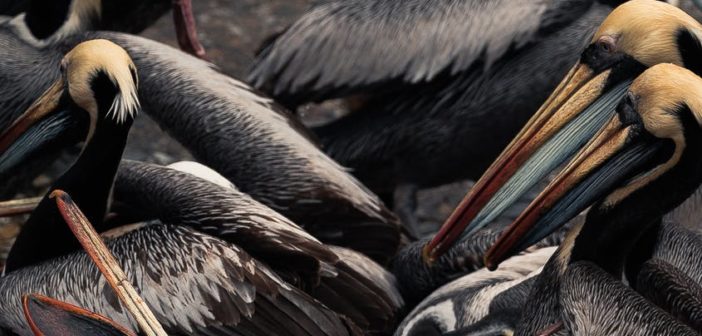By. Kristen Collins, Staff Writer
The world is filled with all sorts of animals going from cute and cuddly to downright terrifying. When exploring the unknown depths of the oceans and scoring through uncharted areas, some of the most horrifying animals can be found. The following are ten creepy and unbelievable creatures across the globe.
Frilled Shark –
While the name may not seem too terrifying, this shark is not cute, frilly, or that much of a shark in appearance. A creature that rarely comes close to the surface of the ocean, the frilled shark is most likely responsible for myths of sea serpents in old sailing history. It is an eel-like shark with a lizard-shaped head, ruffles on its throat, and has a serpentine body ranging 3-4 feet with small fins.
These sea creatures are typically found in the waters near Japan, though have been found in other locations as well. In the wild, they live at water depths that range from 165 to 4,200 feet, though usually never stray from the deeper waters. Frilled sharks have a natural buoyancy, which means they can adjust their bodies for different water pressures, accounting for the wide range of habitable depths.
Goblin Shark –
Named by the Japanese as Mitsukurina, the goblin shark has uniquely terrifying features with a monstrous snout. Both the Japanese and English name are attributed to the fact that the shark’s appearance is like a goblin with a long nose and jagged teeth. There are videos of the goblin shark eating in its natural habitat that show the jaw is able to extend forward to grasp its prey. It can grow to a length of 15 to 20 feet and can weigh up to 460 pounds.
These creatures are notoriously hard to find because they live in the deep sea around 4800 feet below sea level. Living in such a dark environment, the goblin shark has adapted by using their strange grey and pink skin to attract prey. The depths have also given these sharks electro-sensitive skin to make it easier to detect prey nearby. While the goblins of the sea may be harmless to humans, their diets do consist of squid and deep sea fish.
Black Dragonfish –
The black dragonfish is a creature deep within the ocean with a horrifying face, though it is only 15 inches in length. Like many types of deep sea fish, the male and female are completely different in physical appearance. The female is the image of creepiness personified with small beady eyes, a gapping jaw filled with razor sharp teeth, and a body as black as night. In order to attract prey in the darkness, the black dragonfish has a luminescent barb on the chin for unsuspecting fish. The male on the other hand is a minuscule 2 inches in length and only lives for the purpose to reproduce.
This specific species of black dragonfish is found in the northeastern oceans of Australia and is at a depth of 6500 feet. The complete lack of light and extreme pressures have made it so that these fish can create their own form of light, called bioluminescence. The pressure also contributes to the strange, slender and thin shape of the dragonfish.
Gulper Eel –
Staring into the infinite jaws of the gulper eel, wondering if it is smiling or going to eat every living soul is definitely on the list of creepy and horrifying animals. This creature seems to be made up of just a gigantic mouth. The mouth itself is pouch-like while the rest of the body is made up of a skinny tail. As for size, the gulper eel can reach up to 6 feet in length of fleshy, weak body and muscled jaw.
Located in tropical and temperate oceans, these eels are found in depths ranging from 500 to 6,000 feet. Like other deep sea creatures, they have small amounts of luminescent lights as well as ultra-sensitive spines/hairs on its body to detect prey. They feed mostly on small squid and crustacean in the same manner as whale, scooping up large amounts of water surrounding groups of shrimp and other prey.
Angler Fish –
Almost every child has seen the horrid face of the angler fish in all of its glory in the Disney film, “Finding Nemo.” Vacant eyes, a mouth filled to the brim with teeth, misshapen body, and a deceptive beacon of light completely describes the entirety of this deep sea monster.
It is a thing of horror, ranging from 8 inches to 3.3 feet and weighing up to 110 pounds. Thankfully, these monsters are relatively small and are away from humans. Usually grey or dark brown in color, the angler fish’s body mostly consists of a giant head, a mouth filled with translucent teeth, and has plain flesh. Its plain body makes it easier to capture prey that has been transfixed on the fishing pole-like dorsal spine. Both males and female are drastically different from one another: the female being the classic angler fish and the male being a small, parasitic fish.
The angler fish species live in the Atlantic and Antarctic oceans at depths going to 3,000 feet where the water is near freezing and there is an absence of light. Strangely enough, the angler fish is commercially fished around the world and is considered to be a delicacy in Japan. Creepy fish, but supposedly tastes like and has the same texture as lobster.
Shoebill –
At first glance these birds seem to be harmless and share the same appearance of the Skylofts in “Skyward Sword: Legend of Zelda.” A closer look will show that it has a creepily similar appearance to a long-extinct carnivorous prehistoric bird known as the Terror Bird. Whether seen as a cartoon-like bird from a game or a dinosaur-age bird from the past, the shoebill is a bird that can hold its own against many of its prey and predators. This bird has an incredibly large bill with upcurving edges and a hooked tooth. It is both fast and powerful with its massive body, having a height of 3.6 to 4.1 feet with a wingspan of 7 to 8 feet.
The shoebill is located in Africa and prefers to live in swamp or marshy environments. They keep to more open areas to make flying easier and are generally solitary birds. Shoebills eat vegetation and a variety of animals: African lungfish, amphibians, water-snakes, lizards, turtles, young crocodiles, and Lechwe calves.
Aye-Aye –
The real-life gremlins of the world, aye-aye the creatures of childhood dreams with their disturbing, big-eyed faces haunting every corner. These rare primates have ridiculously creepy human-like hands with clawed tips, big and expressive eyes that take up the face, and large ears that are sensitive to sound. Specifically focusing on the hands, each finger is extremely long and spindly which gives a very gremlin-like appearance. Being either dark-brown or black in color, aye-aye have small bodies with disproportionately large tails. Head to body, they measure from 14 to 17 inches and with the addition of the tail, 22 to 24 inches are added.
Living on the island of Madagascar, aye-aye are tree-dwelling primates and avoid the ground most of their lives to keep away from predators. These creatures are also nocturnal, which can contribute to the fact that they have large eyes for better visuals in the dark. Their diets consist of fruits and insects found within the trees aye-aye inhabit.
Hummingbird Moth –
Seeing a cute and adorable hummingbird is always a sight to see…until it is actually a camouflaged moth. These insects look so close to a hummingbird that they are often mistaken for them, which helps in protecting themselves from predators. The moth is 2 inches long and has an olive-green body with red bands. It has tufts of fur, posing as feather, and has wings that are clear with bits of red near the body.
The hummingbird moth lives in Japan and inhabits fields, gardens, and forest edges. Just like a hummingbird, these moths suckle nectar out of flowers from a tube-like mouthpart called a proboscis. Some of its favorite flowers to eat are the Japanese Honeysuckle, Red Clover, and blackberries.
Trogloraptor Spider –
Arachnophobia just blew through the roof with this newly discovered species of spider. The size of a dollar, the trogloraptor spider has primitive origins. The elongated claws are flexible and have teethed hooks of them to capture and hold live prey. Being primitive in origin, the spider has simpler uses with its web. It is used mostly for having a few strings to hang off walls.
The hook-legged spiders were discovered in an Oregon cave. There is speculations that these spiders hid away in caves before parts of the red forest disappeared or were destroyed. From its looks, behaviors, and survival patterns (the use of its webbing), it is obvious that the trogloraptor spider is a relic of old arachnid history.
Amblypygi –
Spiders, spiders, and more spiders of creepy and horrifying proportions comes about with the whip spider or the tailless scorpion. Amblypygi lack spider thread and poison sacks, but do have spider-like fangs. The size of these creatures bodies range around 2 inches, not too scary…until the first pair of legs are measured. At 9.8 inches long, these legs are used as touch receptors to catch prey nearby.
The whip spider is located in warm, humid regions and are usually found under bark, in leaf litters, or sometimes living in caves. Being an arachnid that hunts at night, the pair of long legs are essential to capturing prey in the darkness by using vibrations and chemical signals. While it has no form of poison, the two claws are used to keep their meal immobile as they pierce the soft tissues with spider-like fangs to drink the innards.





